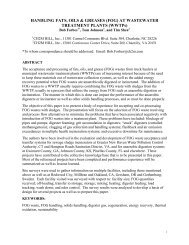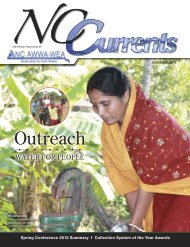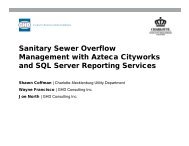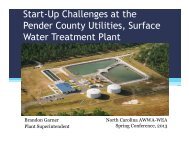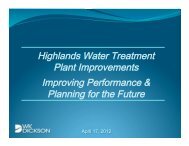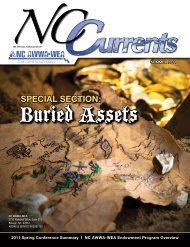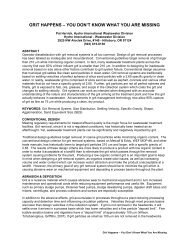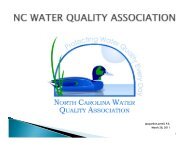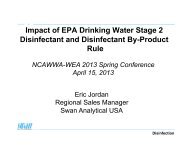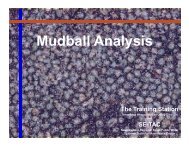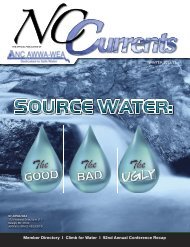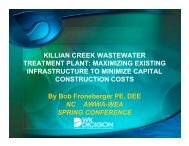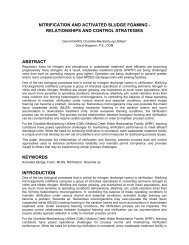TERTIARY CLOTH MEDIA FILTRATION WITHOUT ROTATING ...
TERTIARY CLOTH MEDIA FILTRATION WITHOUT ROTATING ...
TERTIARY CLOTH MEDIA FILTRATION WITHOUT ROTATING ...
You also want an ePaper? Increase the reach of your titles
YUMPU automatically turns print PDFs into web optimized ePapers that Google loves.
<strong>TERTIARY</strong> <strong>CLOTH</strong> <strong>MEDIA</strong> <strong>FILTRATION</strong> <strong>WITHOUT</strong> <strong>ROTATING</strong> DISCS,VACUUM PUMPS OR SPRAY BARSAuthorsKurt M. Lindsley, PE is Director of Filtration Technology at Fluidyne Corporation and the inventor of thefixed plate cloth media technology discussed in this paper. He has 20 yrs of experience designing,operating, and developing new filtration systems for municipal and industrial applications.Monte Ridenhour has 30 yrs of experience in the design, implementation, and operation of wastewatertreatment systems & equipment as a representative at EW2 Environmental, Inc. in Charlotte, NC. EW2 isFluidyne’s Representative in North & South Carolina and can be contacted at the following:EW2 ENVIRONMENTAL, INC.7245 Pineville – Matthews RoadSuite 100Charlotte, NC 28226P: 704-542-2444AbstractFixed plate cloth media low-head filter systems offer Tertiary-Reuse quality treatment of wastewater frommunicipal & industrial secondary treatment processes while providing operators with several keyadvantages when compared to conventional sand filtration or disc type cloth media filters.The advantages are the result of 2 important concepts utilized with fixed plate cloth filters; 1) the latestcloth media does not require excessive pressurized spray or backwash volume to clean and 2) alreadyavailable differential head can be used to produce backwash flow.Simple open-close pneumatic valves control the filtering and backwash operations. The position of thetwo valves associated with each filtering element determines the direction of flow. Therefore, NO pumpsare needed to create backwash flow, which allows media panels to be fixed in place (instead of rotatedpast a stationary spray or suction manifold). Having fixed panels also allows them to be square orrectangular (vs. circular) easing manufacture, installation, removal, and maintenance, while maximizingtreatment area within the tankage footprint.100% acrylic filtering media is fixed within stainless steel elements which remain static during alloperations. This significantly limits mechanical wear and maintenance. The static plate design is alsovery compact compared to many types of granular media or tertiary filters, due to the ability of the clothmedia to be placed vertically, as opposed large flat sand beds. Cloth media also has a significantly higherthroughput capacity than granular media, which further helps to reduce overall tankage size and footprint.Fixed Plate cloth filters operate using gravity, requiring only small water level differential or head to pushwater through the filter cloth, making it ideally suited for treatment facilities located in low lying areas orwhere available gravity head is limited.These advantages all combine to provide a tertiary treatment system which is easy to use, easy tomaintain, inexpensive to purchase and operate, and robust enough to produce re-use quality effluent overa wide range of treatment applications.Tertiary Cloth Media Filtration without Rotating discs, vacuum pumps or spray bars
Keywordsfilter, cloth, media, pile, final, effluent, cloth filter, suspended solids, turbidity, removal, water, tertiary,reuse, recycle, green, technology, wastewater, municipal, municipal filtration, industrial, industrialfiltration, municipal water, municipal wastewater, sewer, water filter, acrylic, pile cloth, cloth media filter,municipal cloth media filter, industrial cloth media filterIntroductionNorth Carolina needs filtration. Specifically tertiary filtration to reduce effluent turbidity and suspendedsolids in discharge from a diverse range of treatment and secondary processes utilized throughout thestate. The applications are wide ranging, from protecting sensitive fishing streams near a Youth Camp inthe Smoky Mountains to treating discharge from coastal development into sensitive coastal waters onEmerald Isle. Tight limits on effluent turbidity and suspended solids have prompted local officials,municipalities, developers and contractors to reconsider their choices regarding conservation, reuse, &wastewater treatment options.It was this increased awareness and regulation that has prompted municipalities & local developers,along with the engineering community in NC, to include tertiary cloth media filtration as part of new andupgraded wastewater collection & treatment systems in order to protect these vital waterways anddischarges.Use and acceptance of cloth media systems for tertiary filtration has been wide-spread in NC asregulations & limits for effluent turbidity and suspended solids discharge have become more strimgent.The benefits of cloth media filtration systems (including higher throughput, reduced footprint, andsimplified media replacement) have allowed these types of systems to all but replace older-style travelingbridge sand filters or other granular media filtration options. Most cloth media filter systems, whencombined with well-run secondary processes, have been proven to reduce effluent solids (TSS) andTurbidity (NTU) to very low levels including TSS consistently below 5mg/l and Turbidities
DiscussionFixed Plate Cloth Media - No Moving Parts – Reduced RedundancyFixed Plate cloth media filter systems offered several key advantages over existing rotating disk style clothmedia filter options. First, rectangular media elements stay fixed in place during all operations (no movingparts), eliminating much of the internal mechanical complexity, maintenance and cost associated with typicaldisk type cloth filter. Fixed filter plate systems use available differential head to produce forward andbackwash flow. Simple open-close pneumatic valves – operated by a small air compressor and simplecontrols - control the filtering and backwash operations and determine the direction of flow, eliminating theneed for pumps, manifolds, and rotating disks. Since elements do not rotate, they can be square orrectangular (vs. circular) easing manufacture, installation, removal, and maintenance. Element frames &tankage are 100% stainless steel, further reducing internal maintenance.Second, individual media elements can be isolated from the remainder of the incoming flow stream and removedfrom the system without disrupting flow to the remaining online elements (reduced redundancy). Multiple isolatedmedia panels within each tank or concrete basin allows incoming water to continue to enter the filter system whileindividual filter elements are being backwashed or are removed from the system. Incoming water is filtered throughremaining on-line filter elements with treated water continually replenishing the clean water reservoir or main tankarea. This liquid level is maintained while individual elements are gravity backwashed. Each element isbackwashed in sequence, allowing complete system backwash without discontinuing or diverting flow during theprocess. During the backwash, flow to only one element has to be discontinued. The filter at Bulverde hascapacity for six media elements, only 1/6 th of which would have to be off-line at any particular time, with theremaining 5/6 th or 83% of the media area remaining online. By sizing the unit to handle design flows with 5 of 6elements installed, one element can be removed from the flow stream without disruption to capacity, upstreamprocesses, or influent treatment.If periodic inspection of media is required, individual media elements can be isolated from the remaining elementsand removed from the filter system for periodic inspection and media replacement, all while flow continues toonline elements Internal components are modularized and integral to the media element (not attached to thetank), which allows all internal components for each element to be removed while flow continues to the otheronline filter elements. Elements can be removed, inspected and returned to service without decreasing systemcapacity or interrupting flow. All media within the system can be changed sequentially, while the remaininginstalled online elements treat the full design flow.The fixed plate filter systems incorporate an ‘inside-out’ flow pattern which is operationally advantageous to thosethat utilize ‘outside-in’ flow (where solids collect on the external areas of the media elements). Fluidyne’s fixedplate filter trap solids and biological material on the inside of the media elements, with cleaned effluent occupyingthe majority of the main tankage volume. This provides several benefits including allowing the operator to readilysee the quality of the effluent, cleaner operation, and reduced operator contact with collected biological solids.Also, since heavier solids settle to the bottom of the filter (which are then removed without additional equipment orpumps during the normal backwash stage), heavy solids never contact the cloth media or need to be ‘handled’.This eliminates the need for hopper bottoms or sludge collection manifolds at the bottom of the main tank.Also, some ‘outside-in’ systems utilize mechanical spray bars for cleaning, which spray high pressure water fromthe outside into the filter media, forcing some solids through the cloth to the clean water or interior side of the cloth,contaminating the effluent. In these systems, a separate 'rinse' cycle is then required where filtered water isdiverted for several minutes after a spray cycle. High pressure spray also damages the cloth media over time,enlarging the filter media openings and causing premature failure and replacement.Finally, since the fixed plate filter systems use simple open-close pneumatic valves and compressed airto provide both fluid flow control and agitation of the media during the air scour assisted backwash, noother mechanical systems are necessary. This significantly limits the power input to the system (a smallPLC to operate solenoids and a small 1-2 hp compressor which only runs during periodic backwashcycles) as well as mechanical wear items & required spare parts.Tertiary Cloth Media Filtration without Rotating discs, vacuum pumps or spray bars
These advantages all combined to provide tertiary treatment that is easier to use & maintain, as well asinexpensive to purchase and operate, while still maintaining reuse quality discharge & effluent treatment.ResultsThe first large-scale fixed plate cloth media filter was setup for testing at the 40 MGD MadisonMetropolitan Sewerage District (MMSD) in summer 2006 and operated successfully through Nov 2007.The original fixed plate cloth media filter system consisted of a stainless steel tank containing four (4)rectangular, fixed cloth media elements each capable of treating 200,000gpd of secondary wastewater(0.8 MGD total). Secondary flow from one of nineteen MMSD clarifiers was diverted to the fixed platecloth media system via a 600gpm self-priming pump, treated, then discharged back into the clarifier’seffluent channel. The entire system was powered by a 1.9hp pneumatic compressor, which along withthe pneumatic open/close valves, were the only mechanical moving components in the system.Flow from the secondary clarifier was pumped to the filter during all phases of filtration and backwash.The filtered effluent that collected in the main reservoir proved to be adequate to produce sufficienthydraulic head to clean the cloth media during backwash operations. The air scour system properlysupplemented the water only backwash and increased cleaning efficiency through added agitation,resulting in backwash efficiency as low as 3% of forward flow during the fall of 2007.Although successful, winter conditions in WI prevented longer term testing of the full-scale unit outdoors.In 2009 a second smaller pilot-scale unit was developed for placement indoors, near MMSD’s UVdisinfection system. This smaller pilot-scale fixed plate cloth media filter system consisted of a stainlesssteel tank containing four (4) rectangular, fixed cloth media elements, each containing 1.5sf of media andcapable of treating 5gpm of secondary wastewater (~30Kgpd total). Secondary flow was diverted fromthe UV distribution channel (prior to UV) treated, then discharged back into the UV channel downstream.TSS (mg/l) 24-‐Hr Composite 10.0 9.0 8.0 7.0 6.0 5.0 4.0 3.0 TSS (mg/l) 24-‐Hr Composite Filter InfluentTSS (mg/L)Filter EffluentTSS (mg/l)2.0 1.0 0.0 05/02/10 06/21/10 08/10/10 09/29/10 11/18/10 01/07/11 Figure 1 – influent vs. effluent TSS from MMSD Pilot-scale performance testing of fixed platecloth media filter.Tertiary Cloth Media Filtration without Rotating discs, vacuum pumps or spray bars
The entire system was powered by a 1hp pneumatic compressor, which again along with the pneumaticopen/close valves, were the only mechanical moving components in the system. The pilot-scale unit wasoperated at MMSD for several months in 2009, then again from May to December of 2010 (7 months).Performance was based on measurement of several key indicators including suspended solids (TSS)removal, turbidity (NTU) removal, and backwash efficiency. Daily Influent TSS fluctuated between 2-8mg/l with spikes up to 20 mg/l TSS periodically. Effluent TSS from the filter system was consistentlybelow 3 mg/l with several grab samples below detection limits of 1.1 mg/l (See figure 1 for TSS data fromMMSD-’10).Influent turbidity, measured with a Hach 900C online turbidimeter, averages roughly 2 NTU, with spikesup to 5 NTU at times. Effluent NTU, measured concurrently with a second turbidimeter, averages below1 NTU with multiple grab samples below 0.6NTU. Daily average NTU during all testing never exceeded1.5NTU (See figure 2 for turbidity data from MMSD-’10).Further testing and demonstration of both the full-scale & pilot-scale fixed plate cloth media filters wereperformed in 2008 through 2010 as part of a nationwide introduction to this new technology.Demonstrations were performed at several plants in WI, VA, NC, SC, TX, and KS.Turbidity (NTU) -‐ Daily Average 5 4 3 2 1 Turbidity (NTU) -‐ Daily Average Filter InfluentNTUFilter EffluentNTU0 05/17/10 06/17/10 07/18/10 08/18/10 09/18/10 10/19/10 11/19/10 12/20/10 Figure 2 – influent vs. effluent Turbidity measured as NTU from MMSD Pilot-scaleperformance testing of fixed plate cloth media filter.Side-by-side comparisons & Total P-RemovalOperators at the Jackson, WI WWTP wanted to compare the performance of the fixed plate cloth mediasystem to their existing traveling bridge sand filters. Jackson had received new discharge permitrequirements which significantly regulated the amount of phosphorous (P) they could discharge, whichpreviously had not been a consideration. Jackson’s operators & supervisors wanted to see how clothmedia filters, and particularly fixed plate cloth media systems, compared to their existing traveling bridgefilter (TBF) sand technology as they prepared to start design of tertiary system upgrades to achieve theTertiary Cloth Media Filtration without Rotating discs, vacuum pumps or spray bars
new P discharge limits. The pilot-scale filter was setup along-side the existing TBF filters and influentfrom the TBF distribution channel was pumped to the filter at variable rates to mimic the hydraulic loadingof the TBFs. Influent & Effluent suspended solids (TSS) as well as influent and effluent TotalPhosphorous (TOT-P) were measured on a daily composite basis. Figures 3 & 4 show resultant TSS, &TOT-P data for the 45 day study period.TSS (mg/l) -‐ Daily Composite 50 45 40 35 30 25 20 15 TSS (mg/l) - Daily CompositeFilter Influent TSS (mg/l)TBF Efflluent TSS (mg/l)FFP Pilot Effluent TSS (mg/l)10 5 0 3-‐Mar 13-‐Mar 23-‐Mar 2-‐Apr 12-‐Apr 22-‐Apr Figure 3 – influent vs. effluent Suspended Solids TSS (mg/l) from Jackson, WI Pilot-scaleperformance testing of fixed plate cloth media filter.Part of the test procedure included experimental dosing of Alum as well as manipulation of the flow to thepilot to simulate various peaking conditions. Alum was purposely overdosed during testing to examinefilter performance under upset conditions. Also, flow was increased from an average equivalent daily flowof 1.31MGD to over 5.25MGD during some periods. Also, the filter influent TSS exhibited extreme TSSfluctuations, with some composite samples in excess of 100 mg/l on several occasions.1.31 MGD 1.75 MGD 2.19 MGD 5.25 2.19 MGD Despite highly variable influent hydraulic, TSS solids, and alum overflow loadings, the fixed plate clothmedia system performed on-par with the existing TBF system, but at an equivalent footprint ofapproximately 40%, meaning existing basins could be upgraded to over double the current filterthroughput without significant changes to piping, hydraulics, or buildings. Furthermore, the fixed platecloth media system exhibited no media fouling, plugging, or degradation throughout the 45 day test perioddespite extreme TSS solids loading fluctuations & heavy alum dosages. Backwash rates remainedconsistent between 4 - 6% during the entire test run.Tertiary Cloth Media Filtration without Rotating discs, vacuum pumps or spray bars
Total-P (mg/l) - Daily Composite2.00 1.80 1.60 1.40 1.20 1.00 0.80 0.60 0.40 Total-P (mg/l) - Daily CompositeFilter Influent Tot-P (mg/l)TBF Effluent Tot-P (mg/l)FFP Pilot Effluent Tot-P (mg/l)0.20 0.00 3-‐Mar 13-‐Mar 23-‐Mar 2-‐Apr 12-‐Apr 22-‐Apr Figure 4 – influent vs. effluent Total Phosphorous (Tot-P, mg/l) from Jackson, WI Pilot-scaleperformance testing of fixed plate cloth media filter.ConclusionFixed Plate systems 1.31 MGD installed 1.75 in NC MGD 2.19 MGD 5.25 2.19 MGD In early 2009, the fixed plate filter technology was chosen as the preferred tertiary treatment technologyto follow new secondary processes for 2 plant upgrades located on Emerald Isle, NC. Both plants havebeen operating since early 2010 and have continually produced & exceeded the effluent requirementsrequired for coastal discharge. A third fixed plate cloth media filter was recently installed at a youth campsouth of Asheville, NC and is expected to be operational in the spring of 2012. Fixed plate cloth mediafilters are currently operating successfully in several states nationwide, including TX, NC, CA, OH, WI, aswell as Ontario, Canada.Fixed Plates w/ air scour function as well as Disks, but without moving parts.Although cloth media filtration and disk filtration are often thought of as synonymous, the developmentand successful implementation of fixed plate cloth media technology have shown that many of theinherent disadvantages & mechanical complexities of the original disk-type system can be eliminatedwithout sacrificing efficiency or effluent treatment quality. By replacing rotating disks, vacuum manifolds,and spray bars with fixed media elements, hydraulic backwash, and air powered media agitation, much ofthe expense, operational complexity, and maintenance requirements can be removed from cloth mediafiltration.Tertiary Cloth Media Filtration without Rotating discs, vacuum pumps or spray bars




